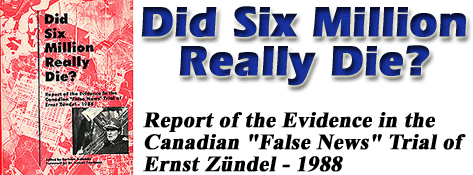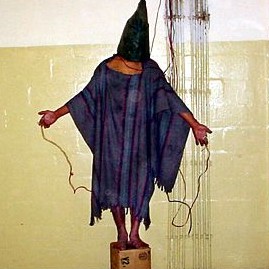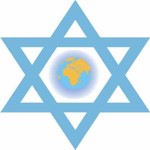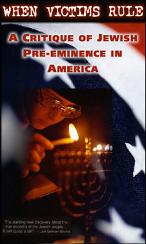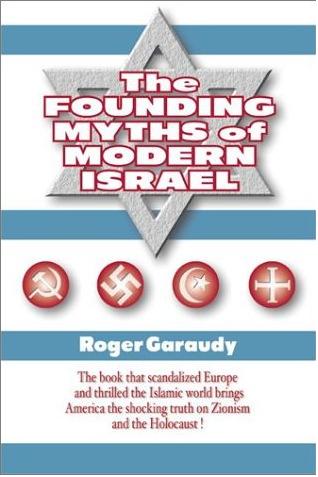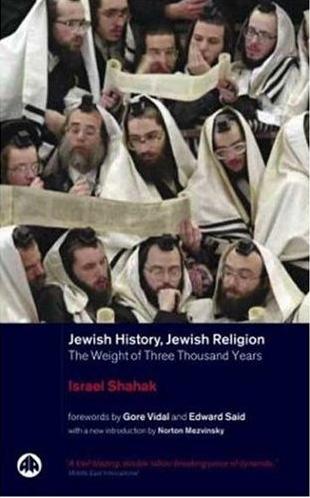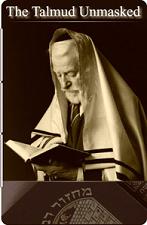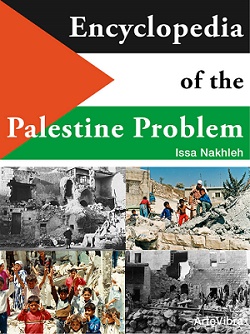Charles Biedermann
[Charles Biedermann was the fifth witness called by the Crown. He testified on February 9, 10, 11 and 12, 1988.]
Charles Biedermann was appointed a delegate of the International Committee of the Red Cross (ICRC) in 1981 and appointed Director of the International Tracing Service (ITS) in 1985. (11-2493, 2495)The management and administration of the ITS was taken over by the ICRC in 1955. Biedermann was employed by the ICRC in Geneva and was required under the Bonn Agreement of 1955 to be a delegate of the ICRC. He spoke as its authorized representative. (10-2403, 11-2495, 2496)
The mandate of the ICRC was to ensure the fulfillment of the Geneva Conventions. There were four Geneva Conventions and two Protocols, all of which dealt with the protection of persons during war. (11-2493, 2494)
The ITS had four mandates: (1) the assembling; (2) classification; (3) administration; and (4) evaluation of documents of former civilian persecutees of the National Socialist regime for the purpose of enabling these people to obtain pension benefits. (11-2496, 2499) The documents were centralized in one main data file, containing about 44 million pieces of information regarding about 14 million former persecutees. (10-2406; 12-2708).
The ITS had processed just over 1.7 million applications since its inception. Payment of compensation and pensions by West Germany currently totaled between 82 and 88 billion marks. West Germany also paid the cost of running the ITS; approximately 10.5 million marks, or $7-8 million Canadian. (12-2715 to 2719)
The actual ownership of the documents rested with the ten Allied governments which composed the supervisory body (International Commission) of the ITS. These ten governments included the United Kingdom, the United States, the Federal Republic of West Germany and Israel. (11-2496, 2497) All documents were archived in the headquarters of the ITS in Arolsen, West Germany. (10-2405)
Access to the documents was limited by the Bonn Agreements of 1955 to former persecutees and their legal successors on the grounds that the documents were all person-related and therefore not open to the public. (11-2497, 2498). The wording used in the Bonn Agreement was that the archives were "only to be evaluated in the interests of the former persecutees themselves or their successors." (12-2676). The only exception to this rule, as provided for under the agreements, was that representatives of any of the ten Allied governments of the supervisory body had the right to inspect the documents. (11-2497) Any application by one of the ten governments for access was reviewed by the Director of the ITS; if the Director felt it was not justified, he could submit the application to the International Commission for the final decision. He could not remember any request by Israel being denied. (12-2711)
The definition of "former persecutee" was set out in the Bonn Agreements of 1955. (12-2716) If a person had been placed in a Nazi concentration camp because he was a common criminal, he could still make application to the ITS for documentation for a pension. The ITS made no distinction in the reasons why persons were detained in the camps. Whether the former criminal received a pension or not, however, depended on the country in which he resided today and what nationality he was. Next-of-kin of former inmates killed by Allied bombing raids could likewise apply for pensions as "persecutees." (12-2718)
The ITS published a three-part annual report. Since 1979, the second and third parts, dealing with the administration of the archives and the inventory of newly acquired documents, were no longer available to the public and were seen only by the International Commission. (12-2720, 2723)
The Special Registry Office was an agency of the Federal Republic of Germany, responsible directly to the Ministry of the Interior of the Province of Hesse and whose mandate was to certify deaths which occurred in concentration camps. (10-2407) The Special Registry Office consisted of two divisions: the preliminary investigation registry and the regular registry. The ICRC and the Special Registry Office were two separate institutions. (11-2498)
If dependents of former persecutees who had died during the war requested a death certificate, the ICRC passed the request together with any evidence it had concerning the individual to the Special Registry Office. Such death certificates were required in order to make restitution or pension claims. (11-2498, 2499) The latter organization decided whether the information was sufficient to certify a death. (10-2407, 2408)
Biedermann confirmed that as of December 31, 1983, the total number of deaths registered with the Special Registry Office and various other registry offices was 373,468. (11-2515) This figure represented death certificates issued pursuant to received applications and was based, with respect to the Special Registry Office, on camp records kept by the Nazis during the war. (11-2516, 2517)
Biedermann agreed that at an international conference held by the International Committee of the Camps in Vienna in 1977, the then director of the ITS, Albert de Cocatrix, gave a speech which indicated that as of December 31, 1976 a total of 357,190 names of persons who died in concentration camps had been registered at the Special Registry Office. Biedermann confirmed that these numbers actually came from the ITS. (12-2640 to 2646) He pointed out, however, that these figures resulted from applications. If an entire family had died, there was no one to make an application for a death certificate. Secondly, the ITS had complete documentation for only two of the twenty-two concentration camps. For the remainder, it had either partial or no documentation. Therefore, if an application was made for a person who had allegedly died in one of these camps, the ITS would not have the records to justify a request to the Special Registry Office for a death certificate. (12-2647)
Biedermann agreed with a statement in the de Cocatrix speech that "persons destined for extermination were brought to the gas chamber without being registered." He gave as an example a Paris-Drancy transport of 1,000 people, where only a part were registered in Auschwitz. Although this did not prove gassings, it proved to Biedermann that they disappeared without coming back again to be liberated. (12-2649; speech entered as Exhibit 26)
To determine whether a deportee obtained a number at Auschwitz, the ITS compared transport lists and arrival dates with the number lists prepared by the Auschwitz Museum in Poland. It also checked other sources which might prove that a deportee was registered, such as an effects card, a sick card or a registration card. (12-2655, 2556) Biedermann believed the ITS had all of the registration particulars from Auschwitz in copy form (12-2661) but admitted that it did not have all of the Auschwitz records "by far." (12-2656, 2657) He later stated that the ITS had the registration camp numbers for every day of the period only "as far as they could be reconstructed" by the Auschwitz State Museum. (12-2663) Other records which the ITS obtained from Auschwitz included copies of death books, cremation lists, death records from the camp doctor and a list about the death books. (12-2661)
Biedermann agreed that in the nineteen instances Did Six Million Really Die? quoted from the Report of the International Committee of the Red Cross on its Activities during the Second World War and Inter Arma Caritas, it did so accurately. He felt, however, that the quotations from the three Red Cross volumes should not have been combined. (11-2530, 2592)
In February, 1978, the ICRC published in its monthly Bulletin No. 25 an article to make it clear, after the publication Did Six Million Really Die? came to its attention, that it did not compile the statistics being attributed to it. He denied it was done pursuant to political pressure. (12-2910, 2921)
Biedermann testified that while records of the ICRC demonstrated that Nazi prisoner of war camps were inspected regularly and found to be well-administered during the war, the records did not show concentration camps to be well administered. (11-2504, 2505)
The ICRC made a distinction between "concentration camps" and "extermination camps." It had records concerning the former, no records concerning the latter, specifically, Treblinka, Sobibor, Chelmno, or Belzec, except for records relating to railway transports. (11-2505, 2506) Biedermann testified that the organization did have records for Majdanek and Auschwitz, as these doubled as both "extermination" and "concentration" camps. (11-2506)
Biedermann testified that the parcel programme to concentration camp inmates was available only to those detainees whose names and places of detention were known to the ICRC. It was therefore available to Nazi prisoners of war from the beginning of the war because their names were known, while the civilian detainees were not known and therefore could not obtain parcels. Supervision by the ICRC relating to people who were interned for security reasons was possible only from March or April of 1945. (11-2508, 2509)
Biedermann testified that the article from Die Tat of Zurich, January 19, 1955, cited by Harwood at page 30 of the pamphlet did not mention the ICRC as alleged by Harwood. (11-2513)
He confirmed several other statements in Did Six Million Really Die?, such as the fact that the ICRC never succeeded in sending any relief supplies to prisoners in Soviet camps and that the ICRC received a number of acknowledgments of receipt from inmates at Auschwitz before the Soviets overtook the camp in January, 1945. (11-2569, 2570) Thereafter, the camp was "liberated" according to the Geneva Conventions and any persons interned there by the Soviets were under the mandate of any national Red Cross organization. (11-2570)
The Crown quoted to Biedermann that part of Did Six Million Really Die? at page 18 in which Harwood quoted from Thies Christophersen's book Die Auschwitz-Luge, in which Christophersen claimed that:
• "...In September 1944 a commission of the International Red Cross came to the camp for an inspection. They were particularly interested in the camp at Birkenau, though we also had many inspections at Raisko."
Biedermann testified that if an inspection by the ICRC of the camp had taken place, the ITS would have the documents, but they did not. While records of the ICRC did refer to a visit to the camp in September of 1944, the delegates did not enter the camp, but were allowed only to see the camp commandant in order to discuss the effectiveness of the current system of distributing parcels to the inmates. The delegates were not able to establish direct contact with the inmates, but were able to meet with several representatives of different nationalities. (11-2501 to 2503)Biedermann testified that in 1987, the ICRC had given the rector of a university in Geneva, as a neutral third party, the mandate to revise the history of the ICRC from 1933 to 1945 as there were uncertainties in some areas, such as the parcel distribution system. (11-2530) The ICRC had been attacked on numerous occasions for not having done enough, specifically for the civilian persecutees in the concentration camps, and one of the reasons for the rewriting was to show that the ICRC had done all that it could do at the time. He could not exclude the possibility that the ICRC was under more pressure in 1988 than in 1948 to emphasize the Holocaust. (12-2744, 2745)
Asked if the ICRC was becoming revisionist in their history, Biedermann replied: "We're human beings like everybody else. If something isn't clear and we become aware of it, we're obliged to correct it." (11-2531) He stated: "The writing of history does not always take place immediately after the events. So the ICRC goes according to the principle, after the completion of a programme, to only 25 years after that completion to draw up a final report, to intentionally gain certain historical distance." (12-2745)
Biedermann was shown a large, two volume work entitled Gedenkbuch, which had been prepared by the State Archive in Koblenz with the assistance of the ITS as a gift from the Federal Republic of Germany to the state of Israel. It was published in 1962 and took the place of a monument stone. The book consisted of pages of names, many of which had beside them the words verschollen meaning "missing," and another German word meaning "unknown." (11-2596 to 2598)
In the preparation of Gedenkbuch, the ITS had been asked to check some 498,000 names that had been collected by the Federal Archive. In the final book itself, there were some 129,000 names. Biedermann could not say what steps the Federal Archive or other archives had taken to see if those persons were alive; for example, by checking the names with Soviet authorities or with the Departments of Vital Statistics in such countries as Canada. (11-2597, 2598)
While the ITS itself did not search records of deceased persons with registries in other countries, many of the applications it handled came via national Red Cross Societies which had tracing service departments making such searches. Biedermann had no personal knowledge, however, of what the Canadian Red Cross, for example, did to check with the Departments of Vital Statistics of various provinces. (11-2599, 2600)
Biedermann could not recall any document from Nazi authorities from between 1939 and 1945 which used the word vernichtungslager, meaning "extermination camp." He did not know the origin of the word but understood it to mean a camp where people were not registered and were never released. (11-2600, 2601)
He acknowledged that in a map contained in the Report of the International Tracing Service, 1986, (Exhibit 25), both Auschwitz and Majdanek were referred to only as "concentration camps" while two other camps, near Riga and Minsk, were referred to as "extermination camps." He did not know whether these camps had ever before been listed as "extermination camps." (11-2602)
It was decided by ITS to classify Auschwitz and Majdanek as "concentration camps" only because the use of both symbols to indicate their double function "would cause further questions in the minds of people [which] would remain unanswered in that case." (12-2632) The only documents which they had for "extermination camps" such as Riga were transport lists to that destination or an order for such a transport. (12-2706)
Under present German law, twenty-two of the camps which existed in Nazi Germany must be called "concentration camps"; these twenty-two camps had together over one thousand sub-Kommandos of different sizes which depended for administration on one of the main "concentration camps." Statistics were reported daily from the sub-Kommandos to the main camps. (11-2603).
The ITS had complete original records for only two of the "concentration camps," Buchenwald and Dachau. Although he knew the ITS had transport records to various camps, he did not know to which camps or transports the records pertained. The transport lists in the possession of the ITS were deemed to be incomplete as the agency had to assume, based on the literature or general documents, that there were more. An example of this was a transport from Drancy, France, of 1,000 Jews, a segment of whom were registered in Auschwitz two days later. The rest of the transport was not registered. Biedermann was aware that prisoners went from Auschwitz to other camps, but did not believe they did so without first being registered. (11-2603 to 2607)
Biedermann knew that the ITS had at least one transport list for Treblinka but did not know how many names were on it. He mentioned that in the Düsseldorf trial regarding the Treblinka camp in the 1960s the court, by expert testimony, set the death figure at 900,000. He did not know whether the ITS provided any records for this trial. (12-2632, 2633)
There were thirty-nine or forty death books from Auschwitz. Of these, the ITS had copies of only three of the books. The remainder were in Moscow (11-2609, 2610) and Biedermann had last requested the authorities in January 1988 for copies. (12-2675) The books were in loose-leaf form and gave the name, date and cause of death for each inmate, together with other data such as detainee numbers. (12-2622)
Although ITS had the complete original Nazi documents from Buchenwald and Dachau, including death lists, it had not made a count of deaths. Asked why, Biedermann said the documents from Dachau alone "would fill a whole hall," and it would exceed the capacity and financial means of ITS to undertake such work. (12-2672, 2673) He later admitted, however, that the ICRC had given the definite instruction to the ITS not to establish or draw up statistics. He stated: "I have the clear order not to draw up statistics, so all the statistics that you might show me now must come from a different source than from our source. The same refers to general historical research and camp records.." (12-2701, 2702)
Shown the chart of deaths in Dachau from 1940 to 1945, Biedermann stated that Dachau had been liberated by the Americans who therefore had large numbers of records concerning the camp in copy form. However, he personally did not have knowledge of the statistics for the reasons given. (12-2701) Biedermann agreed that the German authorities kept meticulous camp records at Dachau and Buchenwald. (12-2674) Biedermann believed that all "extermination camps" were the ones captured by the Soviet forces. (12-2675)
Documents only became part of the ITS inventory after being authenticated. The documents were either copied or filmed on microfiche. ITS was obliged, in the event of a legal dispute, to know the location of the original document and also that access to that original document was guaranteed. (12-2693, 2694)
The ICRC had official camp records of executions in the camps by hanging or shooting. These documents were not marked secret. It was suggested to Biedermann that if exterminations were going on of unregistered inmates in the camps the ICRC had many contacts in Europe to find out about it. Biedermann replied that they had always tried to do so but had never received any confirmations at the time. He agreed there was never any indication by the Red Cross from all its reports that gas chambers were being used during the war. (12-2624, 2625)
He was not aware of any request by the Allies to investigate the accusations of alleged homicidal gas chambers in any of the camps after the war but he knew "for sure" that the ICRC never made any such investigation. (12-2735)
The ITS did not have any records of visits to Auschwitz other than the September, 1944 visit report. Biedermann acknowledged that the 1944 report by Dr. Rossel spoke of a "rumour" of a very modern shower being used as a gas chamber, but that the detainees said nothing about it. He stated that it was definitely possible that the delegate could have spoken to inmates outside of the camp and agreed that the report said nothing about smoke. (11-2613 to 2618) He knew that the commandant's house was very close to the alleged gas chamber in Auschwitz I. (12-2667)
Biedermann agreed that the sentence, "In its relief work for civilian populations, the ICRC paid special attention to the Jews," appeared in volume three of the Report of the ICRC, and explained that this special protection was required especially by civilians persecuted for racial or religious reasons. He agreed that the Joint Relief Committee received large sums from Jews in countries either neutral or at war with Germany, particularly America and Switzerland. He agreed further that at the beginning of the war, the ICRC had considerable contacts with Jews in Europe. He did not agree that this contact extended into 1943 or 1944, except for the parcel distribution programme. He agreed parcels were sent to Auschwitz during the war to Jews. (12-2627 to 2630)
Biedermann stated that the ICRC's parcel distribution programme to the German concentration camps was negatively affected by the Allied blockade and the destruction of roads and railways by Allied saturation bombing. (12-2637).
Biedermann felt the ICRC was impartial during the war and attempted from the beginning of the war to obtain confirmation of rumours of atrocities. He did not know, however, why the ICRC refused the invitation of the German Red Cross to investigate the Katyn Forest massacre. (12-2638) Nor was he aware that the ICRC was invited to witness the exhumation of the bodies at that place. (12-2639) He knew that for many years after the war thousands of German prisoners of war were used as forced labour for the Allied countries, but was unaware of any ICRC report on this matter (12-2727) or of any condemnation by the ICRC of the use of compulsory German labour. (12-2733) Although he was aware of the displacement of large numbers of Germans from their ancestral homes, he believed they were not under the protection of the Geneva Convention. (12-2733, 2734) He did not know anything about the murder of 560 guards at Dachau concentration camp upon its liberation or the fact that photographs existed which showed the presence of an ICRC representative during the massacre committed by American troops. No mention was made of the massacre in the official ICRC report on Dachau. (12-2736 to 2741)
Biedermann was not aware of the ICRC or any delegate ever testifying before in a criminal proceeding for the prosecution of the publisher of a book. (12-2726)
The concepts expressed in this document are protected by the basic human right to freedom of speech, as guaranteed by the First Amendment of the Constitution of the United States, reaffirmed by the U.S. Supreme Court as applying to the Internet content on June 26, 1997.
|
Races? Only one Human race United We Stand, Divided We Fall |
 |
No time to waste. Act now! Tomorrow it will be too late |
|

























